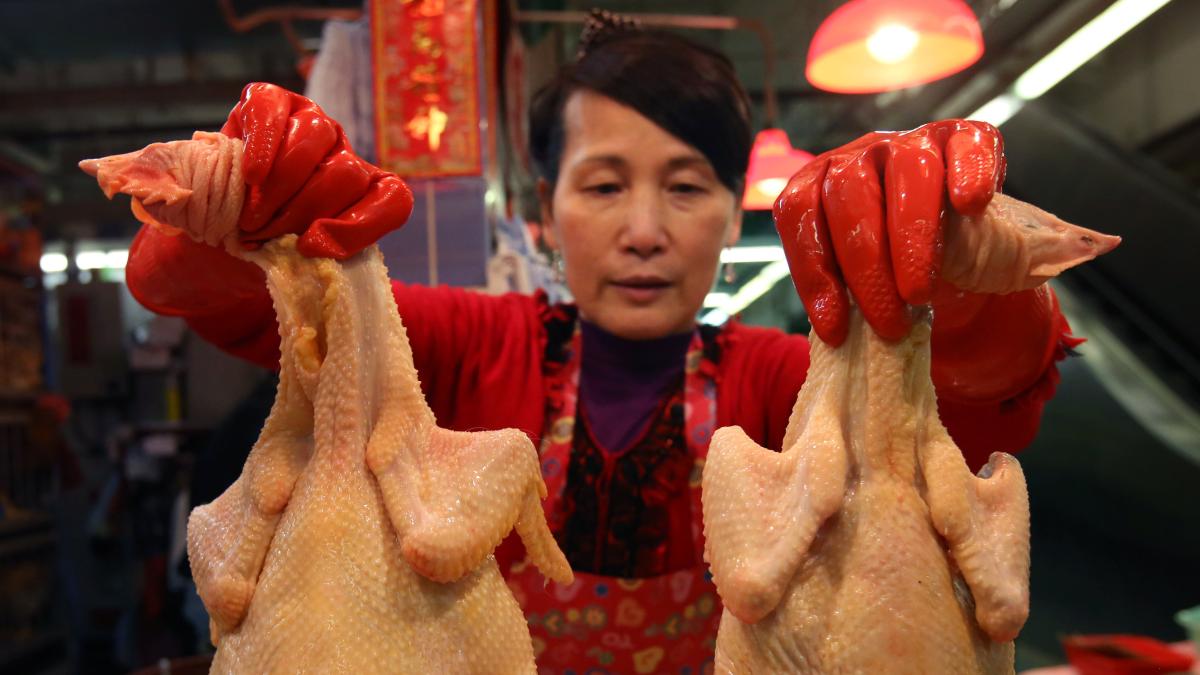ffatty, salty, sweet. The antidote for a hangover is the same all over the world. The restaurant “Wong Ming Kee” in Hong Kong’s Kowloon district also offers the right ambience: nothing strenuous or even formal. A glass door leads from the street directly into the dining room with Formica tables, sky-blue plastic benches and circling ceiling fans.
As soon as you order, the dishes are already on the table: a garlic-heavy pork broth with noodles, fish or meatballs, steamed iceberg lettuce with a black, thick, sweet sauce. Plus a lemonade made out of bright green cans. This type of restaurant is plentiful in Hong Kong. However, it is difficult for outsiders to determine which of these are particularly good.
In this case, outsiders are eleven top chefs from all over the world, all of whom work for the Rosewood hotel group. And who met in the Hong Kong mother hotel to exchange experiences and cook. The day before, on their last night together, they say, they sadly got bogged down in an excellent bar called “The Wise King” in the financial district.
Nevertheless, none of them slept through the upcoming tour, which will be led by their Hong Kong colleague Wong Chun Yee. Yee is the executive sous chef at the hotel’s restaurant, Legacy House. The mid-40s grew up in the Kowloon district and knows the area well – which is why he first takes his gang to the aforementioned “Wong Ming Kee” restaurant. The food there helps, it suddenly awakens the spirits.
Barely identifiable creatures
Hong Kong is street food heaven and hell at the same time. Where to start and where to stop eating? There is an overwhelming range of products, restaurants and dishes, which often cannot be deciphered by holidaymakers due to the language or writing barrier. In addition, there are mysterious displays in the shops and formidable, only partially clearly identifiable animals on the market.
Even polyglot cooks like to be taken by the hand. If you are not lucky enough to be personally guided by a chef, it is best to book one of the food tours that are offered in many districts and for various culinary preferences. Tripadvisor offers a good overview including a rating of the most popular providers, from street food tours to market visits with dumpling workshops and tasting tours through the Mongkok district.
Chef Yee recommends an area close to Kowloon Tasi Park: Nga Tsin Wai Road, with its cross streets lined with small culinary establishments. Coming from the center of the city, you take the subway to Lok Fu and walk through the grounds of the former “Kowloon Walled City”: a place steeped in myth and a model for many dystopian film settings.
33,000 people once piled up in the gloomy high-rise buildings on an area of just 2.7 hectares. The entire complex was demolished in the early 1990s. Today the site is a city park. Not far away is the Kowloon City Wet Market.
Wet markets have not had the best reputation since the Corona pandemic at the latest, as live animals are also sold or freshly slaughtered in the market halls. In this market, at least, everything looks very clean. With the eyes of European animal rights activists, however, one would quickly reach one’s pain threshold.
Whether it’s chickens in cages waiting for buyers next to hatchets and slaughterhouses, buckets of water full of toads, or gasping fish in aquariums: the fact that creatures are offered for consumption and killed for them in Hong Kong – unlike maybe in a German supermarket – not repressed into the subconscious.
Tea shops in Hong Kong would not exist without the British
On the other hand, the magnificent vegetable stalls on the market and in the surrounding streets catch the eye: rows and rows of leafy vegetables and herbs, several types of pak choi, various leeks and heads of cabbage. Yee grabs, examines and evaluates: “There are winter and spring bamboo, they taste different. The same goes for ginger: it is only available fresh two months a year, it is used in completely different dishes than ginger with the brown skin.”
All the chefs on this tour agree that Hong Kong’s culinary scene is the most exciting in Asia alongside Bangkok’s. Asian and European influences meet in Hong Kong – after all, Great Britain ruled the colony from 1841 to 1997, with a short break for almost 150 years.
Sandwiches, for example, or black tea with milk are culinary traces left by the British. From them developed the “Cha Chaan Teng”, Hong Kong’s famous tea houses, which traditionally serve crunchy pineapple buns with butter with milk tea (made with sweetened condensed milk). Nowadays, small rice or pasta dishes are also often served.
Chinese cuisine is much more influential than British cuisine. “Chinese” describes a broad field: “For a long time, Chinese chefs didn’t work in restaurants, but at the emperor’s court or with high-ranking families,” says Yee. Over the centuries, some have come to Hong Kong from China, bringing their local recipes with them.
“China has many cuisines,” he says, “and they’ve all had time to evolve and mingle here. That’s what makes Hong Kong so interesting from a culinary point of view.” He points to the ceiling of a small shop, from which hang fatty, smoked hams and sausages: “Typical for Shanghai,” he says. A street down the road is Sichuan cuisine, known for its spiciness, no dish without chili peppers.
The path of the pasta to Europe
But Europe was also influenced by this side of the world, because noodles came to the old continent from China. Exactly how and when is still a matter of debate today. But the fact is: The pasta culture, or rather the pasta cult, from Hong Kong does not have to hide from the Italian pasta culture.
Yee takes his group to the Chang Ming Kee factory, which is over 100 years old. On the shelves there are screw-top jars in which long, thin noodles reminiscent of tagliolini are folded into small packets. They look a bit like exhibits in the Natural History Museum. They come in all sorts of flavors and colors: traditionally as egg noodles with ground shrimp or dried fish as a mix, but also – hello Italy! – with spinach or tomato.
It only goes on slowly. The eyes are constantly caught on a product, the nose is allowed to demonstrate its range of services. It’s easier to get lost in every little shop here than in the big shopping malls in the city center. Many shops are highly specialized, only selling soup bases, dried or pickled products, spices or tofu.
Hong Kongers are masters at preserving ingredients. Fish belly, first deep-fried and then dried, results in a gelatinous soup when boiled: “Drink, then you’ll be healthy,” is the promise. Some sights take some getting used to, for example the black duck, dried whole and folded up, which looks like it came from an archaeological dig.
Yee continues to guide his group to the “Tsuen Shing Roast Restaurant,” where more appetizing roast ducks hang in the shop window and chicken wrapped in greasy paper sits on a table on the sidewalk. Little things are handed out to the street through the window.
However, there is no say in this case: grilled meat is (along with shrimp dumplings) Yee’s favorite dish. For his group, he chooses pork belly with lots of mustard and crispy duck, which is sweet, salty and sticky at the same time and tastes sensational, much better than the sweet and sour duck that is usual in our Chinese restaurants.
Crispy duck is followed by gooey cake
Then it’s on to dessert. Yee Heung Bean Product Company is all about soybean products, with refrigerators stocking different-sized jars of tofu in shades from creamy to snow-white and in varying degrees of firmness. We eat cool tofu fa from small bowls, the consistency of which is reminiscent of panna cotta and covered in a layer of sugar like crème brûlée. This type of tofu is a popular snack, even for kids after school, says Yee.
Finally, head to the Kwai Yue Cake Shop, which has had its home on South Wall Road since 1948. Its range consists of sweets, sesame biscuits, chocolates and the famous moon cakes: round pies with savory or sweet fillings, which are mainly eaten in autumn. Here they have specialized in these traditional sweets all year round.
Every festival, whether New Year, wedding or the moon festival, has its own desserts and associated rituals. This shop is one of the last of its kind in Hong Kong, says Yee: “The next generation will no longer experience it.”
The morning hangover has now completely gone. The eleven chefs move on to the fish market near Castle Peak Beach in the New Territories north of the city. In the middle of the market is the “Tsing Shan Wan Seafood Restaurant”. Each guest chooses something from the market, which is then gutted and freshly prepared in the restaurant.
Monkfish, razor clams, sea bream: there are hundreds of sea creatures to choose from. The only thing you should stay away from is blood clams, advises a chef from Yee’s group. Although it is a delicacy popular with Chinese people, it can transmit diseases such as typhoid and hepatitis and is “the number one cause of food poisoning”.
Otherwise, you only need two things to enjoy Hong Kong: an elastic stomach and an adventurous mind.
Tips and information:
Getting there: Lufthansa and Cathay Pacific fly non-stop from Frankfurt to Hong Kong; a visa is not required.
Culinary addresses:
Chan Ming Kee Noodle Factory, 77 Kai Tak Road
Local “Wong Ming Kee” for noodle soups and dumplings, 40-42 Sa Po Road
Kowloon City Wet Market, well-stocked indoor market, 100 Nga Tsin Wai Road
Kwai Yue Cake Shop for traditional sweets, 59 South Wall Road
Yee Heung Bean Product Company for tofu specialties, 74 Nga Tsin Long Road
“Tsuen Shing Roast Restaurant” for grilled meat, 40 Nga Tsin Long Road
Cantonese fine dining in the “Legacy House” in the “Rosewood Hong Kong”
Food Tours:
Recommended private providers include Secret Food Tours and Hong Kong Foodie Tasting Tours.
The Hong Kong Tourism Board has put together detailed information on tours and food in general.
Participation in the trip was supported by Rosewood Hotels & Resorts. You can find our standards of transparency and journalistic independence at axelspringer.com/de/Werte/downloads




